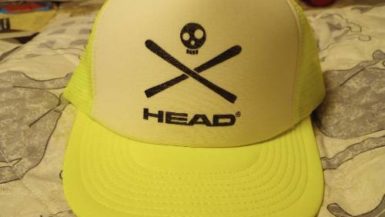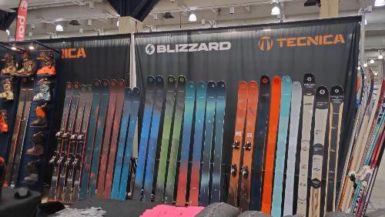
I’m swinging new irons for the first time in 37 years, and it feels like I just got out of prison. As for my last set: Fred Flintstone, here’s your freaking golf clubs back.
“Are those original Ping Eyes?” people would ask me, staring slack-jawed at my golf bag as if they were meeting a Dodo bird.
“Yes, they are. Do you still point at airplanes too?” I’d retort, but they were right. I waited too long to pull the trigger, but no more. I’ve finally done it. I’ve hopped in the DeLorean and come back from the Stone Age. I’m swinging the new Callaway Apex Forged Irons, and loving them like a supermodel.
I don’t know who started the old adage, “you want new woods and old irons,” but they never played 37 years with clubs from 1979. I’ll leave the question of why I took so long to make such an important, imperative change in equipment until later in this review. Your more pressing question is this: How did I come to pick the Callaway Apex Forged?
Fate…dumbest luck ever.
Friends from Boston came into town for a surprise weekend visit, so en masse we invaded a local muni, a place I ordinarily never play, a real cow pasture. (That’s the kind of thing you have to do when eight random people – including one rank beginner – up and decide “let’s go play golf” at 2:30 p.m., but I digress…)
When we get to the ninth hole, a par-3, someone had left their 6-iron on the tee box…a Callaway Apex forged.
It looked like a nice club. Not quite a blade, but also not a sledgehammer, like my PINGs are. I looked at the hole: 155 yards, all carry over water to a severe false front green. I had been hitting my PINGs short and right – the weakest, worst shot in golf. This was not the time for that miss. Moreover, it was time I started looking for new irons, long past time. So for shits and giggles, I thought let’s hit this club and see what happens.
***THWACK!***
15 feet, pin high left. Birdie op. Pure, perfectly natural feel to the swing, the tungsten weight center of gravity catapulting the ball skyward, a towering moonshot of a ball flight, deep and penetrating. I hadn’t hit an iron shot like that in ages. It felt absolutely perfect.
It was love at first sight.
But irons are a major purchase…perhaps the major purchase a golfer makes. So I started asking around to various head pros and distributors about the Apexes.

“Don’t get Callaways,” everyone said. “You want the Titleist AP1s.”
Seriously, two different golf professionals, (including my old coach from when I was a junior), and a single digit handicap friend – the first three people I asked – all told me to try the Titleist AP1s. So I did. I went out and played a few holes with them.
They’re good clubs, but it wasn’t he same. I never felt the ball explode off the face. I never felt the effortless knife-through-warm-butter feel of the club through the ball that I felt with the Apexes.
So I went to Dick’s and tried out about four different sets – TaylorMades, Titleists, Cobras, Whatevers. Again, the magic just wasn’t there, and neither were the results. I felt like Harry Potter trying out wands for the first time in Ollivander’s when he was 11 years old. The club and I just didn’t have that symbiosis, that effortless feel that results in a perfect golf shot. Something was wrong – either the weighting or the balance – something.
At the same time, I asked my old coach if he could fit me. He just looked at me, sizing me up. Then he bellowed like a wounded rhinoceros.
“Fitting?!” he scoffed. “Fitting is for chumps. What do you need to get fitted for? You’ve been terrorizing me since you were eight years old. You’re 1-degree flat because you’re short. Regular shafts because you don’t have the swing speed for stiff. Steel over graphite for control.”
I recalled a similar discussion from around 1982, but as I said before, we’ll get to that in a minute.
So that was that. I placed the order with Callaway, and spent the last four rounds testing them out. One day, for nine holes, I hit nothing but irons, even off the tee, just for practice and gauging distance.
Here’s the results: I’m longer, more accurate, and more consistent. That’s a tri-fecta.
Here’s why:
First, the face of the club has a thin (455 Carpenter) steel face insert that’s ludicrously hot. It’s not catapulting off the face, it’s exploding…erupting. The ball can’t come off the face fast enough or high enough. I’m easily a full 3-5 yards longer, and my ball flight is at least 10% higher. Next, the wide grooves are light years easier to control, and give me a chance to put far more spin on the ball, even from tough lies. The steel shafts actually help groove your tempo, giving you that pause at the top, before the downward explosion out of your coil, for higher launch angles as well as greater distance. Best of all, the tungsten weighted inserts are perfectly placed in the sweet spot for that effortless distance, a dizzying launch angle, paratrooper soft landings.
I’m back to playing lawn darts with my irons.
I didn’t exactly break every rule of club purchasing, but a lot of them. Yes, I took only one swing with the clubs I ultimately got – a total impulse buy – but I tried out an awful lot of everything else and eliminated them. Plus, I had to do this – my PING Eyes were just a cumbersome hunk of metal. They had become totally useless. They had to go. They were the “Bernie’s corpse” of golf clubs.
Besides, when I took that swing with the Apex, the club spoke to me, melded to me. The symbiosis was unmistakable.
What was it Harry Potter used to say? The wand chooses the wizard.
And let me tell you something: I’m a frickin’ wizard, baby! In fact, I’m frickin’ Gandalf. (Okay…Pocket Gandalf…)
So here’s a tip to all the Callaway reps: start leaving random 6-irons on random tee boxes so people can try them out and fall in love with them. These clubs sell themselves.

HOW NOT TO BUY A SET OF GOLF CLUBS
How did I get stuck playing the PINGS in the first place? Good question! This is the story of how not to buy golf clubs – not what you just read above. The answer will illustrate exactly how NOT to a) select the wrong clubs and b) screw up your golf game for years, because it was “conventional wisdom” that stagnated my golf game for over three decades to begin with.
It’s 1982. I was a kid back then, and I was moving up from the crappy set of this-and-that Dad had cobbled in the basement. I had improved significantly – shooting in the low to mid-80s, and I was improving every day. This was the crucial moment when I could potentially make the quantum leap in talent.
My coach and club pro was a grizzled old hustler whose uncle had won a US Open back in the 50s. He had several brands he was hawking, and after hitting a number of different clubs, I decided I wanted something called Maxfli Australian blades. They were a forged club, and a blade, but I hit them beautifully. I took them out on the range and they were silky smooth. Each shot a repetition. Look at that sweet divot pattern! Each iron shot a dart at the hole.
This is what I want, I told my parents.
But I didn’t have a choice.
“You’re getting PINGS,” Mom informed me. “Don’t you want PINGS? Everyone has them. They’re the greatest thing. You’ll hit them beautifully. They’re the best club out there.”
“But look how well I hit these,” I replied. “They feel great.”
“You’re going to get fitted for PINGS. Don’t you want a special session fitting you perfectly? They’ll tailor them exactly to you. They’re the most expensive thing out there. Everyone loves them! Everyone says so! It’s all over the TV and the magazines. You’re getting PINGS! Don’t tell us what you want. We know better.”
I heard it all…well everything except something smart. Something like, “Well let’s see you hit those other clubs, maybe you’re right” or “Okay, tell me more about them, and we’ll discuss it,” or especially, “Hey, they’re going to be your clubs, you have t hit them, so get what you want, and I hope you’re happy, because you’re going to be playing them for a while.”
Nope. I was pushed into a club that never quite felt right. No matter how much fitting, poking, prodding, twisting, turning, and measuring – all in some cryptic fashion more befitting a dotty old tailor looking me over for a cheap suit – I had to adapt to the club rather than the club responding to my will.
“What do you have to do all that?” my coach snarled as the process dragged on interminably. “He’s 1-degree flat because he’s short. Regular shafts because he don’t have the swing speed for stiff. Steel over graphite for control. Give him the Reds…one degree flat.”
And so there they were in my bag: Brand new PING EYES…the ones with the red eye…the hottest brand, the most recent trend.
And the days of my being a single digit handicapper were gone forever.
So here’s “the wisdom” as Hunter Thompson would have put it, the pro tips you really need when purchasing clubs:
1) Buy what you hit well. Never mind what it looks like. Never mind the name on the club. Never mind trends, celebrities, pro endorsements, sales, hype, friends, or recommendations. Get what gives you the best results, and name brands be damned.
2) Never mind fitting until you are a single digit handicapper. Learn how to play first. The average golfer – and that’s roughly half of the people who play regularly – is around a 24 handicap. That’s 12 bogeys and six doubles per round. That guy doesn’t need to worry about his coefficient of restitution or getting a faster swing speed. That guy needs to stop stubbing chips, skulling pitches, and three-jacking. Worry about the more advanced aspects of clubs when your game is good enough to warrant it. Good golfers may become excellent golfers by worrying about those things, but bad golfers never get good by jumping ahead. It’s not like elementary school – you don’t “skip a grade” in golf.
3) Don’t overestimate your talent. If you’re not good enough for stiff shafts yet, why torture yourself trying to bang your head against that wall?
4) Parents, stand down! The last three things you should be influencing are your kids’ clothes, significant others, and golf equipment. Exchanging ideas is one thing, dictating is quite another. One works, the other doesn’t.
Detailed specs on the Callaway Apex Forged Irons
• Thin 455 Carpenter Steel face insert creates an ultra-hot face that increases ball speeds 1-2 mph for more distance;
• Wiiiiiiiiiiiide grooves for more consistent spin from a variety of lies;
• Tungsten weighted inserts in the sole of the long irons for low center of gravity produce higher launch angles and maximum forgiveness;
• 1020 forged carbon steel body for maximum control;
• True Temper® XP95 steel shaft delivers high launch angles with a controlled ball flight for lightweight premium performance
• Lamkin Crossline Grip
4 Iron SPECS:
• Loft: 21.5°
• Lie: 60.5°
• Length: 38.5″
• Swing Weight: D2
5 Iron SPECS:
• Loft: 24°
• Lie: 61°
• Length: 38″
• Swing Weight: D2
6 Iron SPECS:
• Loft: 27°
• Lie: 61.5°
• Length: 37.5″
• Swing Weight: D2
7 Iron SPECS:
• Loft: 31°
• Lie: 62°
• Length: 37″
• Swing Weight: D2
8 Iron SPECS:
• Loft: 35°
• Lie: 62.5°
• Length: 36.5″
• Swing Weight: D2
9 Iron SPECS:
• Loft: 40°
• Lie: 63°
• Length: 36″
• Swing Weight: D2
PW SPECS:
• Loft: 45°
• Lie: 63.5°
• Length: 37.8″
• Swing Weight: D2




